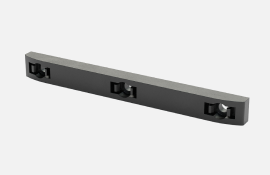Rollers and components for escalators and elevators
Escalators and elevators play a vital part in the infrastructure of any modern building. They move people quickly and conveniently between different levels in shopping centres, airports and railway stations, to name just a few.
Elevators are also vital for barrier-free access and moving people and goods rapidly in multi-storey office complexes, residential buildings and hotels. Both systems enhance safety and efficiency, and deliver added convenience for building users.
Premium-quality components are crucial when it comes to ensuring the smooth and reliable operation of these facilities. And the parts need to meet the highest standards for load-bearing capacity, wear-resistance, durability and safety.
A manufacturer with years of experience, faigle supplies a wide range of products that are designed specifically for heavy-duty escalator and elevator applications.
faigle products for escalators
Each roller for escalators and elevators in faigle’s extensive range performs a specific function:
- Step rollers keep the escalator steps moving and can handle heavy loads as well as high speeds
- Chain rollers transfer drive power to the step chain and ensure precise, quiet movement
- Relief tracks reduce the load on the step chain in the transition curves
- Step bushings connect the escalator steps to the drive chain
- Step demarcations make it easier for users to see the edge of the step, especially in poor lighting conditions
faigle’s plastic rollers and spare parts are a byword for outstanding ride comfort, exceptionally smooth running and safe operation. Approved by OEMs, operators and public authorities, these components set the recognised technological standard for the escalator industry – which translates into maximum safety.
faigle products for elevators
faigle also produces a range of highly reliable, premium rollers for elevators. Guiding rollers are essential components for safe and smooth elevator operation. Thanks to precision guiding of both the cabin and the counterweight in the elevator shaft, they make a major contribution to ride comfort and noise reduction.
faigle’s guiding rollers for elevators:
- 1C counterweight guiding roller
- 2C elevator guiding roller
Advantages:
- Robust: designed specifically to handle heavy-duty operating conditions and heavy loads.
- Durable: high-quality materials ensure a long service life and lower maintenance costs.
- Excellent running properties: smooth, vibration-free and low-noise elevator operation.
- Outstanding performance in sophisticated systems: optimised for installation in state-of-the-art, high-performance elevators.
faigle’s plastic rollers and spare parts deliver superior ride comfort, exceptionally smooth running and safe operation – for escalators and elevators alike. The recognised standard for the escalator industry, faigle’s premium components are now also available for elevator technology applications – ensuring maximum safety for OEMs, operators and public authorities.
Rollers for escalators and elevators
Indoors or out: reliable operation around the clock, even under extreme operating conditions
Escalators and elevators – downloads

<iframe width="512px" height="384px" src="https://www.yumpu.com/en/embed/view/LbiZ2R6cwKvzQ4eX" frameborder="0" allowfullscreen="true" allowtransparency="true"></iframe>
<div style="position:relative;padding-bottom:56.25%;height:0;overflow:hidden;max-width:100%;" data-page-width="452" data-page-height="640"><iframe style="position:absolute;top:0;left:0;width:100%;height:100%;" src="https://www.yumpu.com/en/embed/view/LbiZ2R6cwKvzQ4eX" frameborder="0" allowfullscreen="true" allowtransparency="true"></iframe></div>

<iframe width="512px" height="384px" src="https://www.yumpu.com/en/embed/view/Zoma4IMSsF0P9Kid" frameborder="0" allowfullscreen="true" allowtransparency="true"></iframe>
<div style="position:relative;padding-bottom:56.25%;height:0;overflow:hidden;max-width:100%;" data-page-width="452" data-page-height="640"><iframe style="position:absolute;top:0;left:0;width:100%;height:100%;" src="https://www.yumpu.com/en/embed/view/Zoma4IMSsF0P9Kid" frameborder="0" allowfullscreen="true" allowtransparency="true"></iframe></div>

Quality from faigle
Custom products for escalators and elevators
faigle is much more than just a supplier of plastic parts for escalators and elevators – we’re also a partner you can count on when it comes to developing, optimising and maintaining your systems. We have the years of experience and extensive plastics technology expertise that it takes to develop customised solutions for virtually any application.
How can I help you?
Hi, I’m Markus Röllinghoff. I’ll get you up to speed on all of our products and answer any questions you have on our materials.





